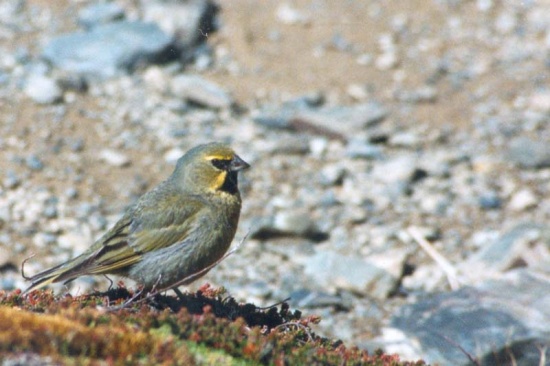Alternative name: Andean Yellow-bridled Finch (barrosi)
- Melanodera xanthogramma
Identification
15 - 17cm. A relatively large finch with very long wings and a triangular bill
Male
- Black lores bordered by yellowish half-supercilium and yellowish eye-crescent
- Black throat bordered by yellowish malar stripes and yellow fringe on lower throat
- Greenish to greyish ear-coverts and crown
- Plain grey upperparts
- Greyish-brown tail and upperwings
- Grey underparts with yellowish-white belly
- White vent and undertail-coverts
- Some birds (green morphe) much greener with bright yellow belly
Female
- Strongly streaked brownish
- Juveniles resembles females but are more heavily streaked
Distribution
South America: found in southern Chile and southern Argentina.
Uncommon to scarce, patchily distributed.
Taxonomy
Subspecies
There are 2 subspecies[1]:
- M. x. barrosi:
- M. x. xanthogramma:
- Southern Argentina (Tierra del Fuego and Cape Horn Archipelago)
Habitat
High altitude grassland. Up to 600m in the south, 3500m in the north of the distribution.
Behaviour
Diet
Feeds on seeds and arthropods.
Forages on the ground, in spring often at edge of melting snow.
Usually seen in pairs, in non-breeding season also in small flocks, mixing with Canary-winged Finch.
Breeding
Breeding season from October to January. The nest is concealed under a boulder or hidden in the grass on the ground. No other information available.
Movements
Descends to lower altitudes in winter.
References
- Del Hoyo, J, A Elliott, and D Christie, eds. 2011. Handbook of the Birds of the World. Volume 16: Tanagers to New World Blackbirds. Barcelona: Lynx Edicions. ISBN 978-8496553781
- Clements, J. F., T. S. Schulenberg, M. J. Iliff, D. Roberson, T. A. Fredericks, B. L. Sullivan, and C. L. Wood. 2014. The eBird/Clements checklist of birds of the world: Version 6.9., with updates to August 2014. Downloaded from http://www.birds.cornell.edu/clementschecklist/download/
Recommended Citation
- BirdForum Opus contributors. (2025) Yellow-bridled Finch. In: BirdForum, the forum for wild birds and birding. Retrieved 12 May 2025 from https://www.birdforum.net/opus/Yellow-bridled_Finch





